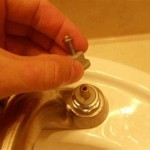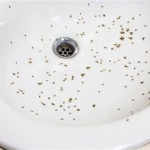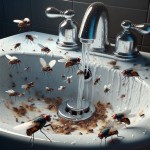What Causes Black Mold in Bathroom Sink Drainage Systems?
Black mold, a type of fungus commonly found in damp environments, can pose a significant threat to human health, especially in areas with constant moisture, such as bathroom sink drainage systems. Its presence can trigger respiratory issues, allergies, and even exacerbate existing medical conditions. Understanding the factors that contribute to black mold growth in bathroom sink drainage systems is crucial for preventing its spread and ensuring a healthy living environment.
1. Moisture and Humidity
The primary catalyst for black mold proliferation is moisture. Bathroom sink drainage systems are inherently susceptible to moisture accumulation due to the constant use of water. When water seeps into the drainage pipes, it creates a humid environment that fosters mold growth. Leaky pipes, overflowing drains, or even condensation from hot water can contribute to excessive humidity, providing the ideal breeding ground for black mold.
In addition, improper ventilation further exacerbates the problem. Bathroom sinks often lack adequate ventilation, trapping moisture within the plumbing system, which can lead to a buildup of humidity and the formation of black mold. Installing exhaust fans that efficiently remove moisture from the bathroom and ensure proper ventilation can help mitigate this issue.
2. Organic Material
Black mold thrives on organic matter, finding sustenance in decaying materials like hair, toothpaste, soap residue, and even dead skin cells. These organic substances accumulate in bathroom sink drain pipes, providing a rich food source for mold to colonize and multiply. The presence of such organic material increases the likelihood of black mold growth, making it essential to maintain clean and hygienic drainage systems.
Regular cleaning of bathroom sink drains with appropriate cleaning agents can effectively remove organic matter and prevent mold growth. Utilizing a drain cleaner specifically designed to break down organic materials and eliminate clogs can significantly minimize the risk of black mold formation.
3. Insufficient Cleaning and Maintenance
Neglecting regular cleaning and maintenance of bathroom sink drainage systems can create an environment conducive to black mold growth. The accumulation of soap scum, hair, and other debris within the pipes can create a barrier that traps moisture, promoting mold formation. Furthermore, failing to address leaks or drips promptly can escalate the moisture problem, further encouraging black mold proliferation.
Regularly cleaning and maintaining bathroom sink drains is essential to prevent black mold growth. Routine checks for leaks, drips, and clogs should be part of a comprehensive cleaning routine. Using a small brush or a drain snake to remove debris from the drain pipe effectively can minimize the risk of mold growth.
4. Poor Plumbing Design
In some cases, poor plumbing design can contribute to black mold in bathroom sink drainage systems. Inadequate venting or improperly installed drainage pipes can lead to stagnant water and moisture buildup, creating an environment that encourages mold growth. Additionally, poorly designed traps or overflows can increase the risk of leaks and drips, further aggravating the problem.
Consulting a professional plumber to assess the plumbing design and ensure proper functionality can significantly reduce the risk of black mold formation. Addressing any potential design flaws or installation errors promptly can prevent future moisture issues and minimize the likelihood of black mold growth.
While black mold in bathroom sink drainage systems can be a significant concern, understanding the causes and taking preventative measures can effectively mitigate the risk. Regular cleaning, proper ventilation, and prompt addressing of leaks and drips are crucial for maintaining a healthy and mold-free bathroom environment.

What Causes Black Mold In Sink Drains How To Get Rid Of It

What Is Black Sludge In A Sink Drain Birnie Plumbing Drains

How To Clear The Black Slime From Your Bathroom Sink

What Causes Black Mold In Sink Drains How To Remove It

What Is Black Sludge In A Sink Drain Birnie Plumbing Drains

5 Signs That You Have Mold Growing In Your Sink Drain

How To Remove Black Mold In Sink Drains Effectively
I Keep Getting A Build Up Of Black Stuff In My Sink What Is It Quora

How To Remove Toxic Mold And Smell In Drain Pipes Safe Inspections

How To Clean Mold In Bathroom Basin
Related Posts







